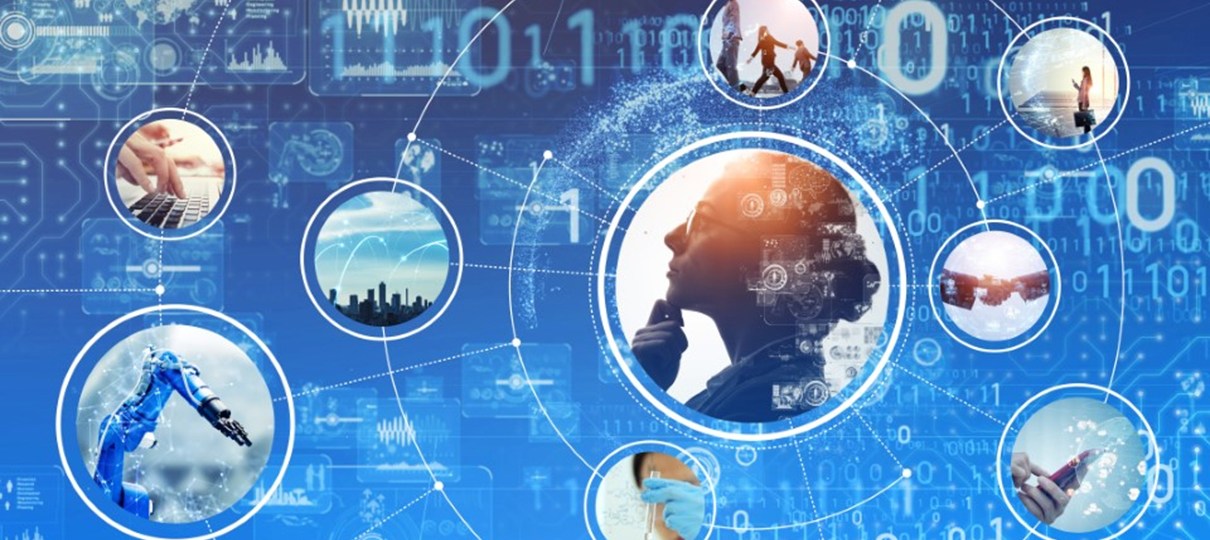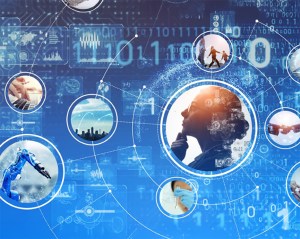As part of its EmergingTech Economic Research Network (EERN) initiative, the Federal Reserve Bank of San Francisco recently co-hosted a public webinar on how small businesses are using generative artificial intelligence (GenAI) tools. EERN is a Federal Reserve Bank of San Francisco initiative in close collaboration with the Federal Reserve System Innovation Office that explores how potentially transformative emerging technologies affect the U.S. economy—and how people, businesses, and communities experience the economy.
In partnership with the Small Business Development Centers (SBDC)1 of Alaska and Nevada, this conversation builds on EERN’s efforts to understand how emerging technologies like GenAI2 are impacting businesses, consumers, and workers in today’s economy, and what that means for the economy of the future. Small businesses make up an important segment of the U.S. economy: Over 99% of US businesses are considered small businesses, and they employ 46% of US workers.3 GenAI is a quickly evolving facet of the small business ecosystem: As of 2024, 20 to 40% of businesses are estimated to have already adopted GenAI in their work.4
Webinar speakers included representatives from the two SBDCs, a construction project management firm, a Community Development Financial Institution (CDFI) supporting small businesses, a youth entrepreneurship program, and business coaching program (all small businesses themselves). They discussed how they and the businesses they serve have incorporated GenAI into their work since it became widely commercially available in spring 2023.
How are small businesses incorporating AI?
Speakers characterized the effect of these tools as transformative, and highlighted ways in which other small businesses could benefit from their adoption across a variety of tasks using readily available GenAI tools, many of which they described as low barrier to entry, with straightforward text-based interfaces.
In helping small businesses identify where they should begin their adoption story, they suggested users think specifically about how to use GenAI to address both routine tasks and pain points in their work.
Examples of how panelists have come to regularly use GenAI in their businesses include:
- Individual productivity: Taking and summarizing meeting notes; identifying and disseminating follow-up action items from meetings; drafting and editing emails and other written communications
- Research and analysis: Market research; finding clients and specialized vendors; analyzing quantitative data; producing figures, charts, and tables; optimizing construction material ordering and distribution across projects to fit standard transportation modes and minimize waste
- Marketing and content creation: Website design and creation; drafting social media posts and website content; generating/editing logos and images; translation
- Back-office operations: Automating Human Resources onboarding processes; drafting business plans, grant applications, Request for Proposal (RFP) responses, and legal contracts
Panelists noted they were able to accomplish many of the above tasks using only readily available commercial tools, although some require customization.
Lessons learned from early adoption
While GenAI has increased their productivity and capacity as small businesses, panelists also cautioned that it is not a standalone “easy button.” They emphasized the importance of the concept of “human in the loop,” that is, that human users must review all AI produced content because:
- Output improves as GenAI gets to “know” you better; it learns user preferences with every interaction, with task repetition, and with materials it is trained on, including approved business documents (e.g., mission statements, annual reports, existing website content), dictionaries (e.g., for translation in sensitive fields including social services) and other material (e.g., official RGB color values).
- AI sometimes “hallucinates,” generating incorrect output when it is uncertain. Panelists recommended that users play with tools’ “temperature” settings to ensure that output accuracy suits the task (for example: hallucination may be a funny inconvenience in meeting note summaries, but a liability if left unreviewed in a request for proposal response) in addition to always reviewing output for comprehension.
- Unedited GenAI output can sound canned or repetitive, which can raise flags—and be a liability—in grant, loan, RFPs, and job applications. In addition, panelists suggested that reviewing and editing output—and understanding how individual tools treat intellectual property—may help guard against complications in the ever-evolving landscape of AI capability and regulation.
Panelists also urged users to understand the terms and conditions of whatever applications they use and consider establishing an organizational AI policy, particularly in organizations that deal with confidential client data—and for which off-the-shelf products may not be appropriate without guardrails that ensure confidential data remains confidential, including personally identifiable information and intellectual property.
On the whole, speakers were optimistic about the potential benefits of AI for small businesses, and as panelists from Alaska highlighted, this is particularly true in rural environments that face unique considerations for their businesses, such as increased transportation costs and challenges finding workers. Watch the accompanying recording to hear more stories about how these people who support small businesses—and themselves operate small businesses—have experienced GenAI so far.
End Notes
1. The US Small Business Administration’s SBDC program provides free, confidential technical assistance and support to small business owners and entrepreneurs: https://www.sba.gov/local-assistance/resource-partners/small-business-development-centers-sbdc.
2. Per the Federal Reserve Bank of Dallas, “Artificial intelligence, or AI, is technology that enables computers and machines to simulate human intelligence and problem-solving capabilities. Traditional AI relies on explicit programming to execute specific tasks. […] These AI programs have been trained to follow given rules and perform tasks, but they don’t create anything new. Generative AI is distinct from traditional AI in that it autonomously generates new content. Examples include written content creation such as ChatGPT, question-answering such as sales or customer service chatbots, and enhanced code or software development.” https://www.dallasfed.org/research/surveys/tbos/2024/2404q.
3. US Chamber of Commerce: https://www.uschamber.com/small-business/small-business-data-center.
4. Crane, Leland, Michael Green, and Paul Soto (2025). “Measuring AI Uptake in the Workplace,” FEDS Notes. Washington: Board of Governors of the Federal Reserve System, February 05, 2025, https://doi.org/10.17016/2380-7172.3724.
The views expressed here do not necessarily reflect the views of the management of the Federal Reserve Bank of San Francisco or of the Board of Governors of the Federal Reserve System.



